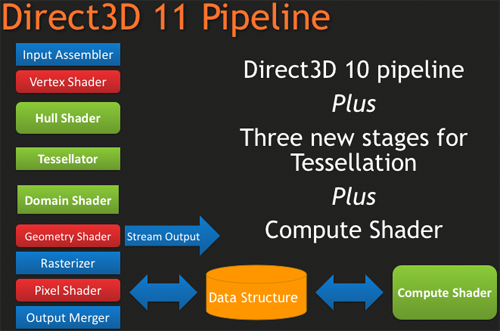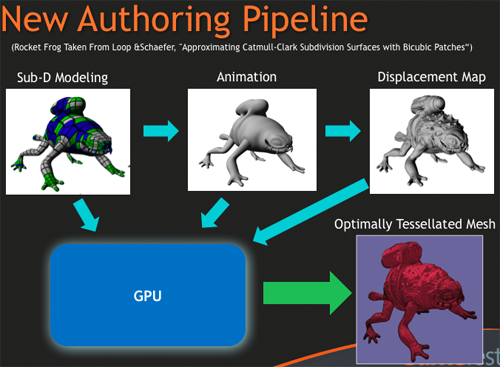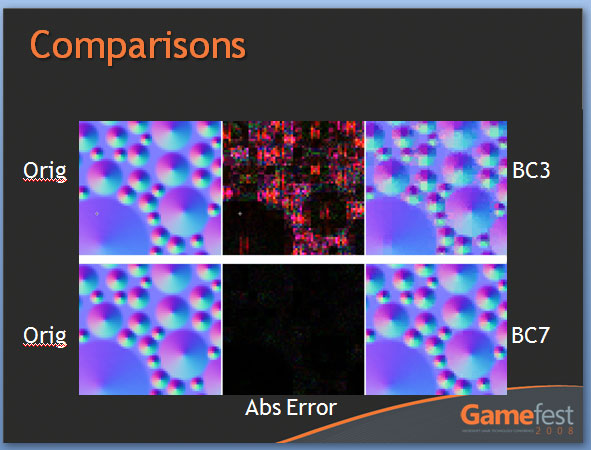AMD's Radeon HD 5870: Bringing About the Next Generation Of GPUs
by Ryan Smith on September 23, 2009 9:00 AM EST- Posted in
- GPUs
DirectX11 Redux
With the launch of the 5800 series, AMD is quite proud of the position they’re in. They have a DX11 card launching a month before DX11 is dropped on to consumers in the form of Win7, and the slower timing of NVIDIA means that AMD has had silicon ready far sooner. This puts AMD in the position of Cypress being the de facto hardware implementation of DX11, a situation that is helpful for the company in the long term as game development will need to begin on solely their hardware (and programmed against AMD’s advantages and quirks) until such a time that NVIDIA’s hardware is ready. This is not a position that AMD has enjoyed since 2002 with the Radeon 9700 and DirectX 9.0, as DirectX 10 was anchored by NVIDIA due in large part to AMD’s late hardware.
As we have already covered DirectX 11 in-depth with our first look at the standard nearly a year ago, this is going to be a recap of what DX11 is bringing to the table. If you’d like to get the entire inside story, please see our in-depth DirectX 11 article.
DirectX 11, as we have previously mentioned, is a pure superset of DirectX 10. Rather than being the massive overhaul of DirectX that DX10 was compared to DX9, DX11 builds off of DX10 without throwing away the old ways. The result of this is easy to see in the hardware of the 5870, where as features were added to the Direct3D pipeline, they were added to the RV770 pipeline in its transformation into Cypress.

New to the Direct3D pipeline for DirectX 11 is the tessellation system, which is divided up into 3 parts, and the Computer Shader. Starting at the very top of the tessellation stack, we have the Hull Shader. The Hull Shader is responsible for taking in patches and control points (tessellation directions), to prepare a piece of geometry to be tessellated.
Next up is the tesselator proper, which is a rather significant piece of fixed function hardware. The tesselator’s sole job is to take geometry and to break it up into more complex portions, in effect creating additional geometric detail from where there was none. As setting up geometry at the start of the graphics pipeline is comparatively expensive, this is a very cool hack to get more geometric detail out of an object without the need to fully deal with what amounts to “eye candy” polygons.
As the tesselator is not programmable, it simply tessellates whatever it is fed. This is what makes the Hull Shader so important, as it’s serves as the programmable input side of the tesselator.
Once the tesselator is done, it hands its work off to the Domain Shader, along with the Hull Shader handing off its original inputs to the Domain Shader too. The Domain Shader is responsible for any further manipulations of the tessellated data that need to be made such as applying displacement maps, before passing it along to other parts of the GPU.

The tesselator is very much AMD’s baby in DX11. They’ve been playing with tesselators as early as 2001, only for them to never gain traction on the PC. The tesselator has seen use in the Xbox 360 where the AMD-designed Xenos GPU has one (albeit much simpler than DX11’s), but when that same tesselator was brought over and put in the R600 and successive hardware, it was never used since it was not a part of the DirectX standard. Now that tessellation is finally part of that standard, we should expect to see it picked up and used by a large number of developers. For AMD, it’s vindication for all the work they’ve put into tessellation over the years.
The other big addition to the Direct3D pipeline is the Compute Shader, which allows for programs to access the hardware of a GPU and treat it like a regular data processor rather than a graphical rendering processor. The Compute Shader is open for use by games and non-games alike, although when it’s used outside of the Direct3D pipeline it’s usually referred to as DirectCompute rather than the Compute Shader.
For its use in games, the big thing AMD is pushing right now is Order Independent Transparency, which uses the Compute Shader to sort transparent textures in a single pass so that they are rendered in the correct order. This isn’t something that was previously impossible using other methods (e.g. pixel shaders), but using the Compute Shader is much faster.

Other features finding their way into Direct3D include some significant changes for textures, in the name of improving image quality. Texture sizes are being bumped up to 16K x 16K (that’s a 256MP texture) which for all practical purposes means that textures can be of an unlimited size given that you’ll run out of video memory before being able to utilize such a large texture.
The other change to textures is the addition of two new texture compression schemes, BC6H and BC7. These new texture compression schemes are another one of AMD’s pet projects, as they are the ones to develop them and push for their inclusion in DX11. BC6H is the first texture compression method dedicated for use in compressing HDR textures, which previously compressed very poorly using even less-lossy schemes like BC3/DXT5. It can compress textures at a lossy 6:1 ratio. Meanwhile BC7 is for use with regular textures, and is billed as a replacement for BC3/DXT5. It has the same 3:1 compression ratio for RGB textures.
We’re actually rather excited about these new texture compression schemes, as better ways to compress textures directly leads to better texture quality. Compressing HDR textures allows for larger/better textures due to the space saved, and using BC7 in place of BC3 is an outright quality improvement in the same amount of space, given an appropriate texture. Better compression and tessellation stand to be the biggest benefactors towards improving the base image quality of games by leading to better textures and better geometry.
We had been hoping to supply some examples of these new texture compression methods in action with real textures, but we have not been able to secure the necessary samples in time. In the meantime we have Microsoft’s examples from GameFest 2008, which drive the point home well enough in spite of being synthetic.

Moving beyond the Direct3D pipeline, the next big feature coming in DirectX 11 is better support for multithreading. By allowing multiple threads to simultaneously create resources, manage states, and issue draw commands, it will no longer be necessary to have a single thread do all of this heavy lifting. As this is an optimization focused on better utilizing the CPU, it stands that graphics performance in GPU-limited situations stands to gain little. Rather this is going to help the CPU in CPU-limited situations better utilize the graphics hardware. Technically this feature does not require DX11 hardware support (it’s a high-level construct available for use with DX10/10.1 cards too) but it’s still a significant technology being introduced with DX11.
Last but not least, DX11 is bringing with it High Level Shader Language 5.0, which in turn is bringing several new instructions that are primarily focused on speeding up common tasks, and some new features that make it more C-like. Classes and interfaces will make an appearance here, which will make shader code development easier by allowing for easier segmentation of code. This will go hand-in-hand with dynamic shader linkage, which helps to clean up code by only linking in shader code suitable for the target device, taking the management of that task out of the hands of the coder.










327 Comments
View All Comments
dieselcat18 - Saturday, October 3, 2009 - link
It truly amazes me that AnandTech allows a Troll like you to keep posting...but there is always one moron that comes to a forum like this and shows his a** to the world...So we all know it to be you...nice work not bringing anything resembling an intelligent discussion to the table..Oh and please don't tell me what it is that I bring to the conversation...my thoughts about this topic have nothing to do with my reply to you about your vulgar manner and lack of respect for anyone that has a difference of opinion.Oh and as for you paper launch...well sites like Newegg were sold out immediately because of the overwhelming demand for this card and I'll bet you anything there are cards available and in good supply at this very moment...Why don't you take a look and give us all another update.....I guess having that big "L" stamped on your forehead sums it up.....
SiliconDoc - Wednesday, September 23, 2009 - link
No, they didn't, because the 5870's just showed up last night, 4 of them, and just a bit ago the ONE of them actually became "available", the Powercolor brand.The other three 5870's are NOT AVAILABLE but are listed....
So "ATI paper launch" is the key idea here (for non red roosters).
1:43 PM CST, Wed. Sept. 23rd, 2009.
---
Yes, I watched them appear on the egg last night(I'm such a red fanboy I even love paper launches)... LOL
crimson117 - Wednesday, September 23, 2009 - link
Current cheapest GTX 295 at Newegg is $469.99.http://www.newegg.com/Product/Product.aspx?Item=N8...">http://www.newegg.com/Product/Product.a...p;cm_re=...
B3an - Wednesday, September 23, 2009 - link
Ryan, on your AA page, you have an example of the unofficial Nvidia SSAA where the tree branches have gone missing in HL2. And say because of this it's not suitable for general use.But for both the ATI pics, on either MSAA or SSAA, the tree branches are missing as well. Did you not notice this? because you do not comment on it.
Either way it looks like ATI AA is still worse, or there is a bug.
Ryan Smith - Wednesday, September 23, 2009 - link
We used the same save game, but not the same computer. These were separate issues we were chasing down at the same time, so they're not meant to be comparable. In this case I believe some of the shots were at 1600x1200, and others were at 1680x1050. The result of which is that the widescreen shots are effectively back a bit farther due to the use of the same FOV at all times in HL2.As you'll see in our Crysis shots, there's no difference. I can look in to this issue later however, if you'd like.
chizow - Wednesday, September 23, 2009 - link
Really enjoyed the discussion of the architecture, new features, DX11, Compute Shaders, the new AF algorithm and the reintroduction of SSAA an ATI parts.As for the card itself, its definitely impressive for a single-GPU but the muted enthusiasm in your conclusion seems justified. Its not the definite leader for single-card performance as the 295 is still consistently faster and the 5870 even fails to consistently outperform its own predecessor, the 4870X2.
Its scaling problems are really odd given its internals and overall specs seem to indicate its just RV790 CF on a single die, yet it scales worst than the previous generation in CF. I'd say you're probably onto something thinking AMD underestimated the 5870's bandwidth requirements.
Anyways, nice card and nice effort from AMD, even if its stay at the top is short-lived. AMD did a better job pricing this time around and will undoubtedly enjoy high sales volume with little competition in the coming months with Win 7's launch, up until Nvidia is able to counter with GT300.
chizow - Wednesday, September 23, 2009 - link
Holy....lolI didn't even realize til I read another comment that Ryan Smith wrote this and not Anand/Derek collaboration. That's a compliment btw, it read very Anand-esque the entire time! ;-) Really enjoyed it similar to some of your earlier efforts like the 3-part Vista memory investigation.
formulav8 - Wednesday, September 23, 2009 - link
I wouldn't be surprised if most of us already knew what was going to take place with performance and what-not. But its still a nice card whether I knew the specs before its official release or not. (And viewed many purposely leak benches). :)Jason
PJABBER - Wednesday, September 23, 2009 - link
Another fine review and nice to see it hit today. Your reviews are one reason I keep coming back to AT!Unfortunately, at MSRP the 5870 doesn't offer enough for me to move past the 4890 I am currently using, and bought for $130 during one of the sales streaks a month or so ago. Will re-evaluate when we actually start seeing price drops and/or DX11 games hit the shelves.
wicko - Wednesday, September 23, 2009 - link
It would have been nice to see 4890 in CF against 5870 in CF. 500$ spent vs 800$ spent :p